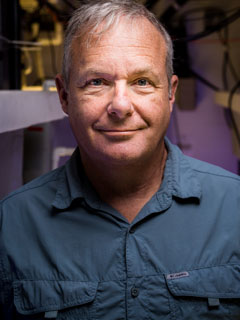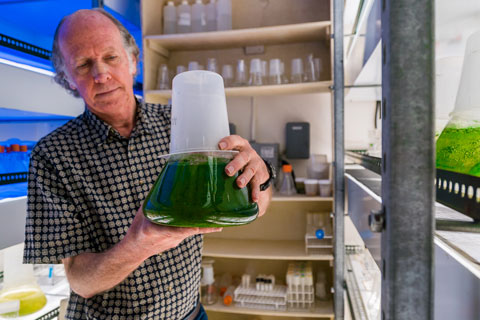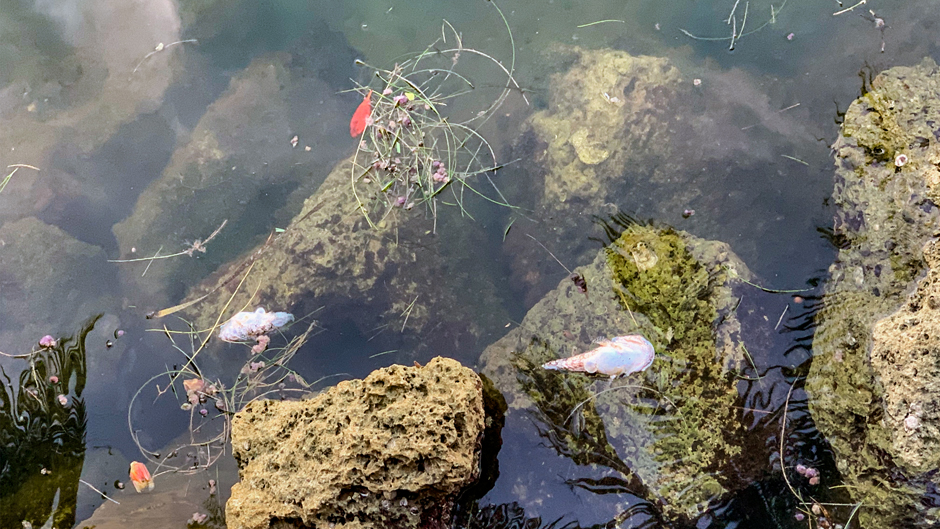When University of Miami graduate student Charles Groppe began to record the data from his water sampling trip in Biscayne Bay two weeks ago, he was a little alarmed.
The oxygen levels in some of the samples he had collected from northern Biscayne Bay were extremely low, and the water was more green than previous weeks. These elements—coupled with warm weather and calm seas—can often signal a threat to survival for marine life, so Groppe immediately showed the data to his advisor, marine biology and ecology professor Chris Langdon at the Rosenstiel School of Marine and Atmospheric Science. The pair then shared the information with a network of local scientists and environmental advocates set up during last summer’s fish kill. That event led to the death of nearly 27,000 fish in Biscayne Bay, according to a report from Miami Waterkeeper.
Two days later, their dire predictions came true. The evening before Labor Day, residents from North Bay Village and western Miami Beach began reporting dead fish—and the stench—along their shores. And Groppe’s data was telling because the fish were dying from what’s called hypoxia, or a lack of oxygen in the water.

“This used to be a rare event, but Biscayne Bay is becoming less resilient and more susceptible to these events, so it’s all the more pressing to prevent them,” said Langdon, who studies ocean acidification.
While this summer’s fish kill was smaller than last year’s, and only hundreds of fish floated ashore, there is a possibility for more events this year, since the water in Biscayne Bay often does not cool off until October, said Rachel Silverstein, executive director of Miami Waterkeeper and a Rosenstiel School alumna.
That’s why Langdon and Groppe have been surveying the waters of Biscayne Bay twice a week since May. They are focusing on the hottest months, when fish kills typically occur, and are looking at different parameters in the water, like temperature, dissolved oxygen, salinity, turbidity (how cloudy the water looks), and concentrations of algae, to see if they can pinpoint some of the causes for these events. They are also in touch with a network of other local marine experts, as part of the Biscayne Bay Science Coordination Group, formed by Miami Waterkeeper to share data and brainstorm new avenues for investigation.

“I hope our research—and everyone else’s—will help identify what factors we can influence to stop these events from occurring. So, we don’t have to just hope that it will not turn into a larger environmental fish kill next summer,” Groppe said.
Although there was a small event in 2019, the thousands of dead fish that washed ashore in August 2020 was the worst fish kill in recent memory for South Florida, Silverstein said. She hopes this summer’s follow-up does not indicate a yearly trend for North Biscayne Bay. In 2015, Biscayne Bay was named a Habitat Focus Area by the National Oceanic and Atmospheric Administration (NOAA) to “fight for the area’s well-being against multiple growing threats.” Some of those threats include nutrient runoff from the county’s many residential septic tanks—which are leaching into the water table and eventually reach Biscayne Bay—as well as from sewage leaks, stormwater runoff, and fertilizer overuse, according to the researchers.
“We are at a concerning tipping point with respect to the fate of Biscayne Bay,” said marine biology professor Danielle McDonald, who studies fish physiology with a focus on Gulf toadfish, a hearty species that represented 44 percent of the casualties in last summer’s event. “Toadfish are very tolerant to hypoxia. So, the fact that many toadfish died last summer shows how serious it was ... and that other factors might be at play. As these events continue, you can imagine certain species of fish will start to disappear from the bay.”
Potential catalysts
Scientists are still trying to understand what sparked this summer’s fish kill. A consensus among local scientists points to pollution as the source of an overall decline in the health of Biscayne Bay, Silverstein noted. Last summer, Langdon said, additional stress was added by a large outflow of polluted water from the Little River Canal, but conditions have been different this year.
“We still don’t know why the event was triggered this year. It’s probably the fact that we have high pollution levels in North Biscayne Bay, which has also killed off the seagrass in the area,” Silverstein said. “But when you have an underlying pollution problem and you add the stress of hot weather, then you become very vulnerable to these type of fish kills.”
Similar to last summer’s event, the conditions in the past few weeks were ideal for low oxygen levels in the water because of the dramatic heat, along with the calm winds, Langdon pointed out. Less wind on the bay means that not as much oxygen can get into the water from the surface, which is critical for fish to thrive, he added.
“When it’s hot, the water near the surface heats up and becomes lighter, so a thin layer of water at the surface acts like a blanket and impedes the oxygen from getting down,” Langdon noted. “There’s typically a top warm layer of water and a colder layer below it, and the only way that oxygen gets down to where fish live is if the two mix.”
Still, hindering marine life even more, experts said, is the fact that Biscayne Bay is filled with nutrients from septic tanks across Miami-Dade County, and sporadic content from broken sewer lines that seeps into the ground. Also, summertime rains draw water mixed with lawn fertilizer, trash, chemicals, pet waste, and other pollution from the street into canals like the Little River that feed into northern Biscayne Bay. When these nutrients dissolve in the bay, they often stimulate algae blooms, which decompose and then absorb all of the oxygen, Langdon explained. The blooms also kill off seagrass, which helps produce oxygen in the Bay, according to Silverstein.

“A little algae is good. But the problem is when you dump extra nutrients into water, you often get more algae, the water turns green, and there are many negative effects,” said marine biology and ecology professor Larry Brand, who studies algae growth extensively and has surveyed Biscayne Bay. “And here in Biscayne Bay, when you get a lot of algae, it takes the oxygen out of the water and kills fish. This is why you see some fish gasping for air at the surface.”
However, Brand noted that there is also the possibility that years of runoff nutrients settling at the bottom of Biscayne Bay may be absorbing the oxygen and producing hydrogen sulfide, a gas that is extremely toxic to fish. He mentioned that more research is needed to determine if that is happening.
A familiar spot
Along with the climate, another similarity of the past three South Florida fish kills is their location. All have taken place in northern Biscayne Bay, a smaller, more enclosed section of the waterway north of the Rickenbacker Causeway. Brand, Langdon, and Silverstein all agree that because North Biscayne Bay is heavily developed, with few outlets for the ocean to flush fresh water into the area, it is simply not as clean as southern Biscayne Bay. This may also be why seagrass beds have died off northwest of the Julia Tuttle Causeway (Interstate 195) in recent years, Groppe explained.
“North Biscayne Bay is built right up to the water’s edge and there are four canals that discharge water from the city into the Bay,” Langdon said.
Brand spent years surveying Biscayne Bay and found that the areas where pollution was the worst were right at the mouth of canals, even in the cleaner southern part of the Bay. Research indicates that nutrient runoff from canals often triggers a loss of seagrass beds, often called the ocean’s nurseries because they harbor baby fish, shrimp, and crabs. Seagrass also stabilizes the sediment at the bottom of the Bay, Silverstein added.

Yet, the problem of nutrient pollution is not limited to South Florida. Fish kills across the world are typically a result of low oxygen levels that occur because of nutrient pollution, McDonald said. During the summer months, the mouth of the Mississippi River becomes one of the largest hypoxic “dead zones” in the world, and marine life often die or stay away from the area in the Gulf of Mexico because of its low oxygen levels. The annual event—which is predicted and monitored by the U.S. Environmental Protection Agency (EPA)—is the result of nutrient runoff from farming states upstream, she added. “This is where Biscayne Bay is headed if we don't control the nutrients we are dumping into the Bay,” McDonald said.
Possible solutions
So, how can residents protect Biscayne Bay from fish kills? First of all, they can stop fertilizing their lawns during the hot, rainy months of the summer, Langdon suggested, which will hopefully prevent the harmful chemicals from entering the bay.
“We need to get nutrient pollution under control in South Florida,” Silverstein added. “Things like nitrogen and phosphorus make plants grow on land, but they overfertilize the algae in water. And as soon as they are added to land and it rains, this fertilized water washes down the drain and that gets into Biscayne Bay and causes pollution.”
A new county law was passed recently to stop locals from fertilizing in Miami’s warmest months; in addition, Miami Waterkeeper was able to persuade commissioners to adopt a year-round ordinance banning fertilizer use within 20 feet of storm drains and waterways.
Still, a larger goal is to get Miami-Dade County’s nearly 120,000 homes still on septic tanks connected to sewer lines that would funnel the sewage into water treatment plants. Silverstein and Brand agreed that this would take a major investment but would likely stop polluted runoff water from seeping into Biscayne Bay.
“The whole area around north Biscayne Bay is covered in dense septic tanks with a very shallow water table and there’s also a lot of industrial areas with runoff into the canals,” Silverstein said. “Therefore, there’s a lot of pollution in North Biscayne Bay.”
Using a grant funded by the EPA, her organization is currently analyzing the water quality in four waterways that feed into northern Biscayne Bay. By collecting samples from Arch Creek, the Oleta River, the Little River, and the Biscayne Canal, the research team is hoping to learn more about the water traveling into this region of the bay. And as part of the project, Miami Waterkeeper is working with faculty members from the University of Miami and Florida International University, as well as with staffers from Beta Analytic, a Miami-based testing lab.

